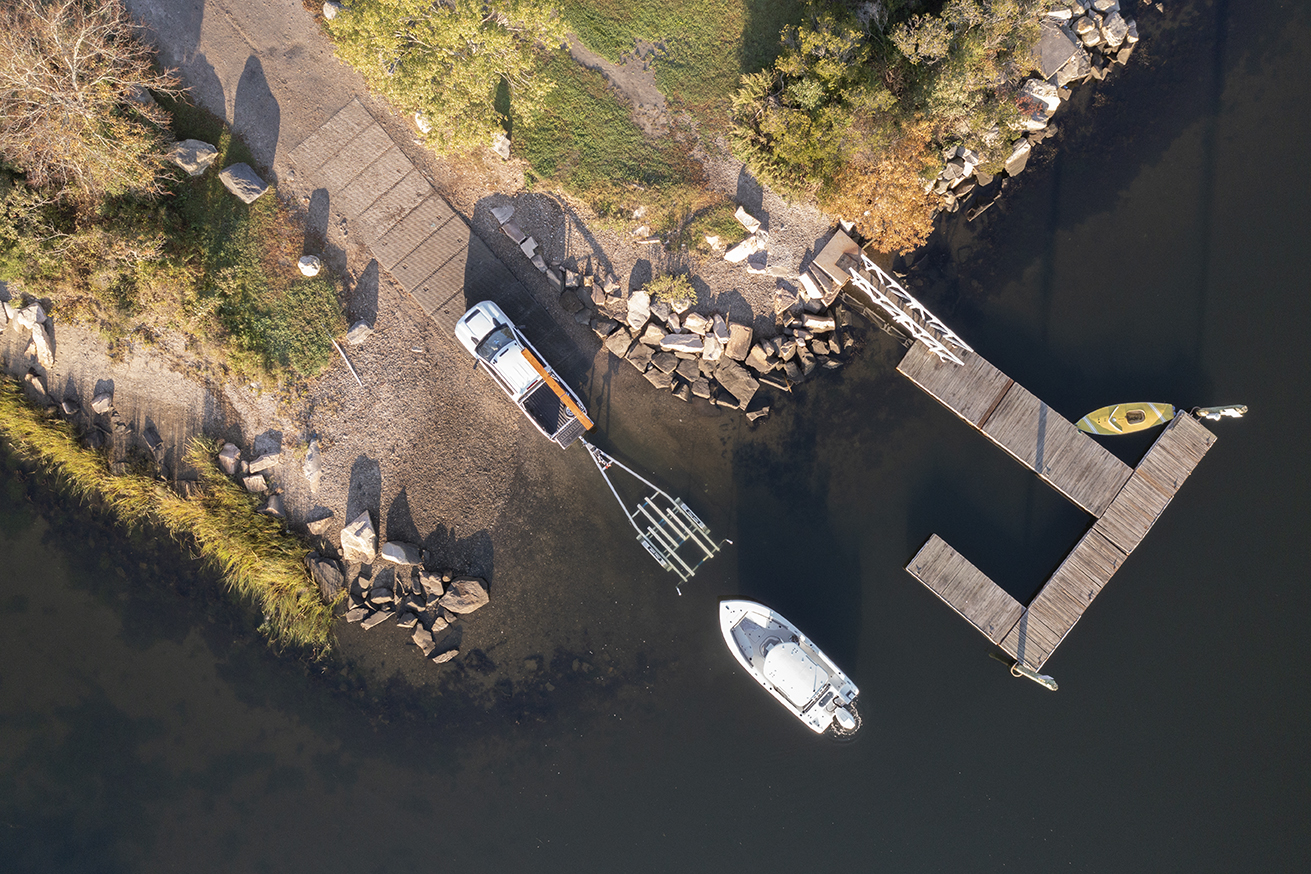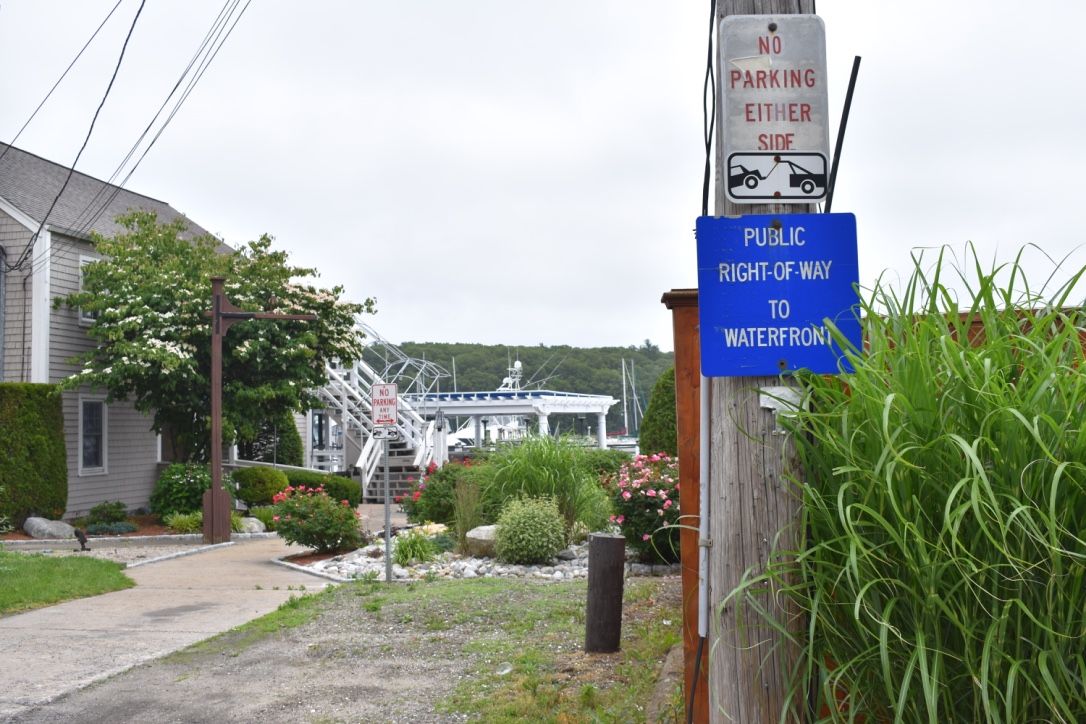by Amanda Valentine, Rhode Island Sea Grant Communications Intern
Spaces along Rhode Island’s beautiful coastline are highly coveted. Determining just how to share these spaces can be a significant source of confusion and conflict. Rights-of-way (ROWs), defined by the Rhode Island Coastal Resources Management Council (CRMC) as “a piece of land over which the public has right to pass on foot, or if appropriate by vehicle,” help secure public access to the shore and balance public and private interests. ROWs often include features like beaches, boat ramps, historical sites, and bike paths.
“All cities and towns are required by the CRMC to have a harbor management plan, and considering rights-of-way is part of the harbor management plan,” said Barbara Ray, public access representative for the North Kingstown Harbor Commission, during a recent webinar hosted by CRMC and Rhode Island Sea Grant on the role of municipalities and nonprofit groups in establishing and protecting ROWs to the shore. “When a project on the waterfront of any town is being developed, the CRMC requires them to have a public access plan.”

The boat ramp in Wilson Park, one of the state’s newly designated shoreline rights-of-way in North Kingstown.
As people move to and develop property along the coast, previously open areas diminish, and along with them access to the shore. Securing public access to these areas is accomplished, according to CRMC, through “a continuous process of discovery and designation of ROWs using a standing ROW subcommittee.”
In 2020, North Kingstown established its own subcommittee consisting of two members of the harbor commission, two members of the conservation commission, and the town staff person for each committee. According to Ray, this committee works to identify potential ROWs and submit candidates to the town council and CRMC. They have also outlined goals to enhance the existing network of ROWs, including improved signage, parking, and public information dissemination.
North Kingstown isn’t the only town making innovative team efforts: just south of Warwick, situated along Greenwich Cove, East Greenwich has six public access points to the harbor reaching from Scalloptown Park at the south to Division Street in the north. Long Street, falling in the middle of these two points, marks the site of a public access puzzle. One of the current boat ramps on the street, though constructed in the most intuitive location for a ROW on that side of the harbor, resides within the private parking lot of a local business. Meanwhile, the area’s actual public access points are situated elsewhere along the harbor, in places blocked by docks.
Andrew Nota, town manager of East Greenwich, took to solving this problem with a rather unusual agreement between the CRMC, East Greenwich, and the business owner.
“This is an ongoing conversation we’re having with the property owner regarding a possible land swap,” he said. While “land swaps” are not particularly common, the agreement between the three parties would reallocate this boat ramp as a public ROW and would provide a replacement parking space for the business. “We’re working collaboratively to try and solve this problem, and really create a win-win for both sides.”
AT THE CORE OF THE CONFLICTS IS “FEAR OF CHANGE…”
Once established, ROWs require consistent care and maintenance, lest commercial, residential, and even verdant encroachment gradually block access. To help share this responsibility, the CRMC, in collaboration with Rhode Island Saltwater Anglers Association (RISAA), formed the “Adopt-an-Access” program in 2005. Members of RISAA—often volunteers who live nearby—agree to visit an adopted location to ensure not only that it is in good condition, but also that its visitors treat it with care.
The integration of ROWs into neighborhoods can spark protests of “NIMBY,” or “Not In My Backyard.” Residents often raise concerns with an easement’s maintenance needs and the potential bad behavior of visitors, such as noise, dog waste, litter, and disregard for danger.
At the core of these conflicts is “fear of change in general,” explained Ray, “and fear that that change will alter the character of the place.”

The King Street right-of-way in East Greenwich
“In this case, we worked with the CRMC, Laura Miguel from CRMC, and the town of Middletown, and we were able to have that landowner remove the caution tape, stakes, and stones, so that access became open again,” said Hittinger. “It really is a continuous battle in some cases to keep these ROWs free and clear … of vegetation … and sometimes the access deteriorates with erosion and steps and things falling apart.”
This sort of neighborly encroachment is not rare: all three—Nota, Ray, and Hittinger—underlined parking as a primary concern.
“Unfortunately, there is no inherent parking allowance built in when a ROW is established, so town councils gradually heed requests from neighbors that parking be restricted, which essentially ends up privatizing the shore,” said Ray.
Even when parking is available, nearby boat owners, workers, or fishermen will often occupy the limited parking spots for an entire day or more. Nota suggested that lack of signage and communication regarding the intent of the ROW results in challenges of this kind; Hittinger echoed the importance of the “Adopt-an-Access” signs that RISAA has recently added to their locations, and Ray’s subcommittee listed improved signage as a distinct goal of theirs.
Despite the immense patience and consistency required to properly care for a ROW, leaders like Ray and Nota have expansive plans for their towns in the coming years. North Kingstown’s committee intends to continue to use GIS mapping to find candidate locations and submit them to the town council and CRMC. Nota has hopes of adding to Rhode Island’s already extensive network of public trails by integrating a path traversing the shoreline from Scalloptown Park, at the south of Greenwich Cove, through East Greenwich and up to Warwick. Built upon collaboration and held together by community effort, these ROWs will continue to offer Rhode Islanders the opportunity to appreciate their local landscap
